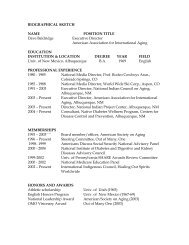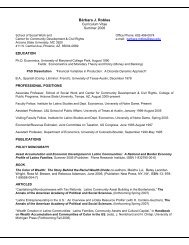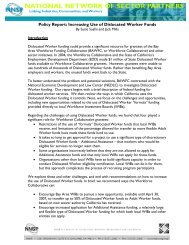Saving Patterns and Probability of Success in Individual ...
Saving Patterns and Probability of Success in Individual ...
Saving Patterns and Probability of Success in Individual ...
You also want an ePaper? Increase the reach of your titles
YUMPU automatically turns print PDFs into web optimized ePapers that Google loves.
<strong>Sav<strong>in</strong>g</strong> <strong>Patterns</strong> <strong>and</strong> <strong>Probability</strong> <strong>of</strong> … 9<br />
from the program.<br />
Our goal <strong>in</strong> this section is to test the hypothesis that regular savers st<strong>and</strong> a better chance <strong>of</strong><br />
reach<strong>in</strong>g their required sav<strong>in</strong>gs limit, ceteris paribus. For this purpose, a regression analysis <strong>of</strong><br />
sav<strong>in</strong>gs is conducted where the dependent variable can take on only two values: one, if the<br />
accountholder has completed sav<strong>in</strong>gs, <strong>and</strong> zero if s/he has not. In addition to a constant term,<br />
success or failure <strong>in</strong> completion <strong>of</strong> sav<strong>in</strong>gs is expla<strong>in</strong>ed by the number <strong>of</strong> months <strong>in</strong> the program<br />
(total months s<strong>in</strong>ce open<strong>in</strong>g account), the deposit ratio (i.e., the ratio <strong>of</strong> number <strong>of</strong> deposits over<br />
months to complete deposits– see table 3 above), average deposit per bank visit, activity ratio<br />
(expla<strong>in</strong>ed below), <strong>and</strong> f<strong>in</strong>ally, a dummy variable for program type (homeownership vs.<br />
microenterprise) <strong>in</strong> order to capture the effect <strong>of</strong> differences <strong>in</strong> sav<strong>in</strong>gs limits <strong>in</strong> the two<br />
programs.<br />
In Table 4, the variable Prob denotes the dependent variable. As mentioned above, this is a<br />
b<strong>in</strong>ary variable that takes on the value 1 if the participant has reached the sav<strong>in</strong>gs goal <strong>in</strong> either<br />
one <strong>of</strong> the programs, <strong>and</strong> 0 otherwise. 10 Though the dependent variable takes on only two values,<br />
the b<strong>in</strong>ary response equation could basically fit any number between zero <strong>and</strong> one (hence the<br />
probability <strong>of</strong> success) based on the values <strong>of</strong> estimated parameters <strong>and</strong> the given explanatory<br />
variables. Among the explanatory variables, C denotes the constant term, <strong>and</strong> I measures months<br />
<strong>in</strong> the program. For every participant, the first month <strong>of</strong> deposit is taken to be the first month <strong>in</strong><br />
the program. Participants stay <strong>in</strong> program for as long as they ma<strong>in</strong>ta<strong>in</strong> a positive balance <strong>in</strong> their<br />
accounts, usually until purchase <strong>of</strong> asset or term<strong>in</strong>ation. Variable M measures the deposit ratio.<br />
As expla<strong>in</strong>ed above, this variable is the ratio <strong>of</strong> the number <strong>of</strong> deposits to months until<br />
9














